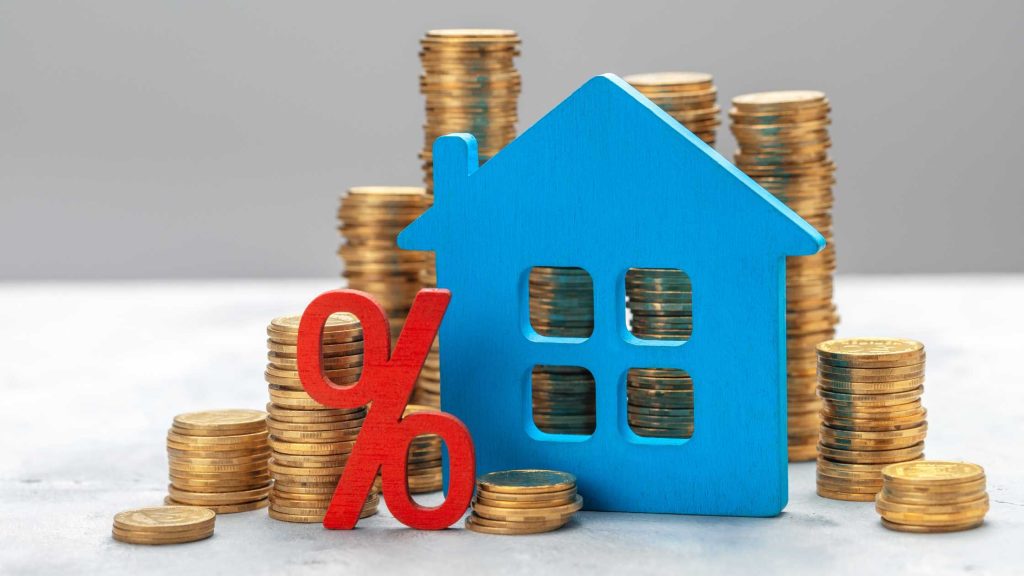Benefits of Taking a Home Loan : In 2025, the Indian financial landscape continues to evolve rapidly, and among the most significant financial instruments available to individuals is the home loan. With rising property prices, changing interest rate regimes, and increasing aspirations for home ownership, home loans have become not only a necessity for many but also a strategic financial decision.
Table of Contents
This comprehensive guide explores the benefits of taking a home loan in 2025, highlighting key financial advantages, tax savings, long-term investment potential, and how the current market conditions favor borrowers more than ever before.
What Is a Home Loan and Why It’s Popular in 2025

A home loan is a financial product offered by banks, NBFCs (Non-Banking Financial Companies), and housing finance companies to help individuals purchase residential property. The borrower repays the loan amount with interest over a fixed tenure through EMIs (Equated Monthly Installments). Home loans can be availed for various purposes including buying a new or resale property, constructing a home, or even renovating an existing one. In 2025, more Indians are turning towards home loans as a smart route to homeownership.
Also Read : Home Loan Eligibility Criteria
The government’s push for affordable housing, lower interest rates, and enhanced digital loan approval processes have made home loans more accessible than ever. With millennials and Gen Z stepping into the real estate market, the trend of home financing continues to soar. Home loans are no longer just a necessity but a financial planning tool used strategically to benefit from tax deductions and wealth creation.
Lower Interest Rates: A Major Benefit in 2025

One of the major benefits of taking a home loan in 2025 is the historically low interest rates. Due to RBI’s controlled repo rate and increased competition among lenders, many banks are offering home loans starting from as low as 8.25% per annum. Floating interest rates have made EMIs lighter, and borrowers now have better flexibility in choosing a tenure that fits their budget.
With interest subvention schemes and balance transfer facilities, even existing borrowers can renegotiate better terms. For new buyers, this is one of the best times in decades to lock in a long-term financial commitment at competitive interest levels. The affordable nature of home loans in 2025 ensures that buying a home is no longer a distant dream.
Tax Benefits on Home Loans: Save More in 2025
Home loans in 2025 come with attractive tax benefits that make them financially rewarding. Under Section 80C of the Income Tax Act, borrowers can claim a deduction of up to ₹1.5 lakh on the principal repayment. Additionally, under Section 24(b), you can claim up to ₹2 lakh on the interest paid on the home loan annually. First-time homebuyers can also benefit from an additional ₹50,000 under Section 80EE if they meet the eligibility criteria.
These tax deductions substantially reduce your taxable income, translating into significant yearly savings. In the long run, the total tax benefit on a home loan could exceed ₹10 lakhs, especially if you’re a salaried individual in the higher tax brackets. This dual tax benefit on both principal and interest makes a home loan one of the most tax-efficient financial products in India today.
Build Wealth Through Real Estate Appreciation
Unlike renting a property where payments do not generate long-term value, paying EMIs towards a home loan helps you build a valuable asset. Every EMI you pay increases your equity in the house. Over the years, as the loan amount decreases, your ownership stake in the property increases. In a growing real estate market like India, property values appreciate significantly over a 10 to 20-year period.
By the time your loan is fully repaid, you not only own a debt-free home but also an asset that has likely appreciated multiple times. This capital appreciation makes a home loan not just an expense but a sound investment. Home ownership also enhances your credit profile and improves your financial standing, making future borrowing easier and more affordable.
Improve Credit Score and Financial Discipline
Taking a home loan also instills financial discipline. When you commit to a long-term EMI payment, you’re naturally inclined to plan your finances more prudently. Regular EMI payments ensure a healthy credit history, which directly contributes to building a high CIBIL score. This makes it easier to get other loans like car loans, personal loans, or even business loans at better rates. Financial institutions favor customers with a strong repayment history, and home loan EMI payments play a crucial role in demonstrating creditworthiness. Over time, this disciplined financial behavior can open up additional credit opportunities and investment options, creating a robust financial portfolio.
Home Loan: The Best Form of ‘Good Debt’
Unlike other loans such as personal loans or credit card debt that have high-interest rates and no asset backing, home loans are considered “good debt.” This means they help you acquire a tangible, appreciating asset while also offering fiscal incentives like tax deductions and better credit scoring. Home loans are generally secured loans, which means they come with much lower interest rates and longer repayment tenures, making them financially manageable. In addition, financial advisors often suggest leveraging good debt like home loans while investing your remaining funds in high-growth instruments such as mutual funds, SIPs, or equity. This way, you’re optimizing your overall returns while still securing a residential property.
Top-Up Loan Benefits in 2025
In 2025, many financial institutions offer top-up home loans to existing borrowers at attractive interest rates. These top-up loans can be used for renovation, furnishing, or any personal financial requirement. The interest rate on these top-ups is usually much lower than a personal loan, making it an ideal way to raise additional funds without the burden of high EMIs. This makes a home loan not only a financing tool for property purchase but also a channel to fund other life goals.
Government Schemes and Subsidies for Home Loans

The Indian government continues to support homeownership through schemes like the Pradhan Mantri Awas Yojana (PMAY) which offers credit-linked subsidies on home loans for first-time buyers in specific income brackets. These subsidies reduce the burden of EMIs and make property ownership possible even for economically weaker sections and middle-income groups.
Additionally, there are stamp duty concessions and special interest rate discounts for women borrowers and co-applicants. In 2025, the government has further digitalized the subsidy claim process, making it more efficient and transparent. Taking a home loan under these schemes can provide significant cost savings and financial relief.
Digital-First Home Loan Process in 2025
In 2025, applying for a home loan has become easier than ever, thanks to digitization. Most banks and housing finance companies have adopted paperless verification and instant loan approval technologies. With Aadhaar-based KYC, e-signatures, and instant CIBIL checks, your home loan can be approved within hours. Platforms like DigiLocker and ePAN verification have eliminated the need for physical documentation.
This hassle-free digital process makes the entire home loan journey smooth, especially for tech-savvy millennials and busy professionals. You can now apply, track, and manage your home loan online without ever visiting a branch.
Home Loan Balance Transfer: A Smart Move
If you’ve taken a home loan from a bank with a high-interest rate, you can transfer your outstanding balance to another lender offering lower rates. This is known as a home loan balance transfer, and it’s one of the smartest ways to reduce your overall interest burden. In 2025, many banks are offering zero processing fee and quick transfer facilities for eligible applicants. Borrowers can not only enjoy lower EMIs but also restructure their repayment tenure. This flexibility helps borrowers optimize their home loan strategy according to changing financial situations.
Real Estate as a Long-Term Investment
Real estate in India has proven to be a solid investment class over the past two decades. With urbanization, infrastructure development, and growing population density, residential property prices are expected to increase steadily in the coming years. By taking a home loan in 2025, you’re essentially locking in your property at today’s price while benefiting from its appreciation over the next 10-20 years. Renting may seem cheaper in the short term, but home ownership through loans ensures you’re investing in an asset that grows in value and gives you long-term security and potential passive income through rentals or resale.
Flexible Repayment Options in 2025
Some lenders offer flexible repayment options in 2025 such as step-up EMIs, where you pay lower EMIs initially that gradually increase as your income grows. Others offer moratorium periods where you can start paying EMIs after a few months. These options are especially helpful for young professionals or entrepreneurs who expect a rise in income over the years. Flexible repayment options ensure that borrowers can structure their home loans in a way that doesn’t strain their monthly budgets while still enabling them to own a house.
Improved Financial Standing with a Home Loan
For salaried professionals, having a home loan is often considered a mark of stability by financial institutions. It can improve your profile for future loans and even increase your chances of obtaining visas or government approvals where financial credibility is assessed. A well-maintained repayment history with a home loan enhances your creditworthiness and demonstrates fiscal responsibility to both private lenders and public institutions.
Home Loans for Property Investors
If you’re a property investor, taking a home loan in 2025 helps you leverage your investment capital. Instead of locking ₹1 crore in a single property, you can use that amount as down payment for multiple properties with the help of home loans. This way, you diversify your investments while still gaining from real estate appreciation. Additionally, interest paid on home loans for let-out properties can be fully claimed as a deduction under Section 24, further reducing your tax liability. Smart investors often use this leverage to grow their portfolios faster.
Benefits for NRI Borrowers
For NRIs (Non-Resident Indians), taking a home loan in India in 2025 offers benefits like repatriation of funds, tax savings in India, and securing a residential asset in their homeland. Many Indian banks have NRI-specific home loan products with attractive interest rates, online application support, and relaxed eligibility criteria. In a growing real estate market, an NRI home loan is a powerful tool for wealth creation and future security.
Benefits of Taking a Home Loan – Conclusion:

In conclusion, the benefits of taking a home loan in 2025 extend far beyond just buying a house.
Buy Now : Options Trading Master Class
From low interest rates, attractive tax deductions, and investment leverage to financial discipline, digital ease, and long-term asset creation, home loans are a powerful financial instrument for wealth building and tax efficiency. With the Indian real estate sector showing strong potential and the lending environment becoming increasingly borrower-friendly, now is the ideal time to invest in a home through a structured home loan plan.
Disclaimer : The information in this article is for educational purposes only and should not be considered financial advice. Always consult a financial advisor or banking representative before making any major financial decisions.
Keywords : Benefits of Taking a Home Loan – Benefits of Taking a Home Loan 2025 – Benefits of Taking a Home Loan guide








